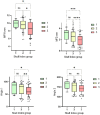Morphological and morphometric measurement of the temporomandibular joint of small and medium-weight dogs with different skull shapes
- PMID: 38784652
- PMCID: PMC11112034
- DOI: 10.3389/fvets.2024.1407761
Morphological and morphometric measurement of the temporomandibular joint of small and medium-weight dogs with different skull shapes
Abstract
Background: The recognition and diagnosis of canine temporomandibular joint (TMJ) disease can be a challenge, often leaving them undiagnosed. Although computed tomography (CT) has proved to be highly efficacious in detecting joint disease in the TMJ, morphometric and morphological studies of the normal TMJ have been scarce. Especially, skull type specific anatomical differences of the TMJ in dogs of different weights and skull morphologies have received limited attention.
Objective: This study aimed to compare the TMJ morphologies of dogs across different weight classes and skull types.
Study design: Retrospective study.
Methods: CT scans were used to measure the depth and width of the Fossa mandibularis and two angles between the Fossa mandibularis and the Caput mandibulae in a total of 92 dogs and 182 mandibular joints, respectively.
Results: The TMJ varied in terms of weight groups and skull indices. Shallow mandibular pits, underdeveloped retroarticular processes, and reduced joint congruency were observed particularly in light-weight and brachycephalic dogs. Conversely, dolichocephalic animals displayed deep joint pits, pronounced joint congruency, and a well-developed Processus retroarticularis.
Main limitations: Observer learning curve; not every skull shape was represented in each weight group.
Keywords: computed tomography; morphometry; small animal; temporomandibular disorders; temporomandibular joint.
Copyright © 2024 Quadflieg, Volk, Sake and Metje.
Conflict of interest statement
The authors declare that the research was conducted in the absence of any commercial or financial relationships that could be construed as a potential conflict of interest.
Figures









Similar articles
-
Morphologic and Morphometric Description of the Temporomandibular Joint in the Domestic Dog Using Computed Tomography.J Vet Dent. 2016 Jun;33(2):75-82. doi: 10.1177/0898756416660008. Epub 2016 Aug 3. J Vet Dent. 2016. PMID: 28326983
-
Morphological Assessment of the Temporomandibular Joint in Asymptomatic Brachycephalic Dogs Using Computed Tomography.J Vet Dent. 2024 Mar;41(2):137-147. doi: 10.1177/08987564231171529. Epub 2023 Apr 27. J Vet Dent. 2024. PMID: 37113019
-
Comparative morphometry of the temporomandibular joint in brachycephalic and mesocephalic cats using multislice CT and cone beam CT.J Feline Med Surg. 2021 Jun;23(6):507-512. doi: 10.1177/1098612X20960657. Epub 2020 Oct 8. J Feline Med Surg. 2021. PMID: 33030097 Free PMC article.
-
Introduction of temporomandibular joint and skull base combined reconstruction by autogenous bone graft.Clin Oral Investig. 2023 Jun;27(6):2513-2520. doi: 10.1007/s00784-023-05065-4. Epub 2023 May 24. Clin Oral Investig. 2023. PMID: 37221432 Review.
-
Review of emerging temporomandibular joint total joint replacement systems.Br J Oral Maxillofac Surg. 2019 Oct;57(8):722-728. doi: 10.1016/j.bjoms.2019.08.009. Epub 2019 Aug 25. Br J Oral Maxillofac Surg. 2019. PMID: 31455594 Review.
References
-
- Nickel R, Schummer A, Wille K-H, Wilkens H. Gelenklehre, arthrologia. In: Frewein J, Wille K-H, Wilkens H, Augsburger H, editors. Lehrbuch der Anatomie der Haustiere Band I: Bewegungsapparat 8., unveränderte Auflage ed: Verlag Parey. (2004), 215–221.
LinkOut - more resources
Full Text Sources

